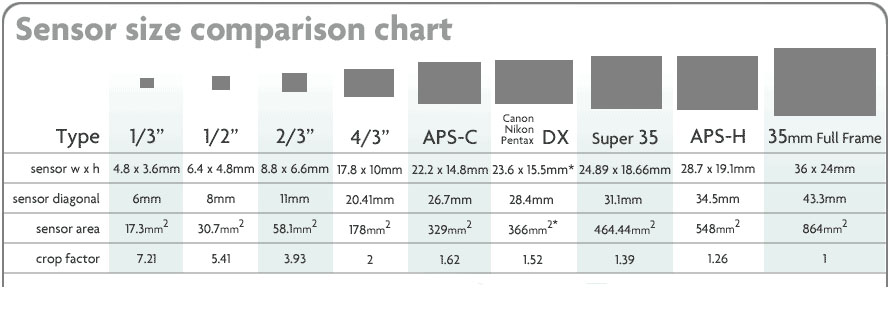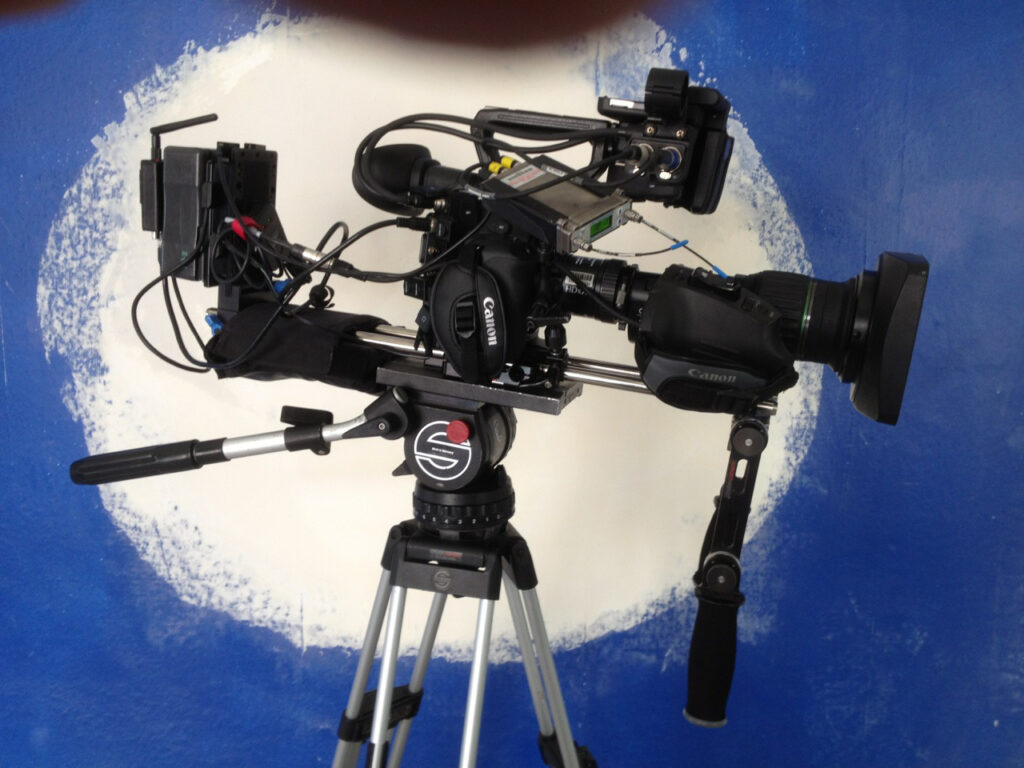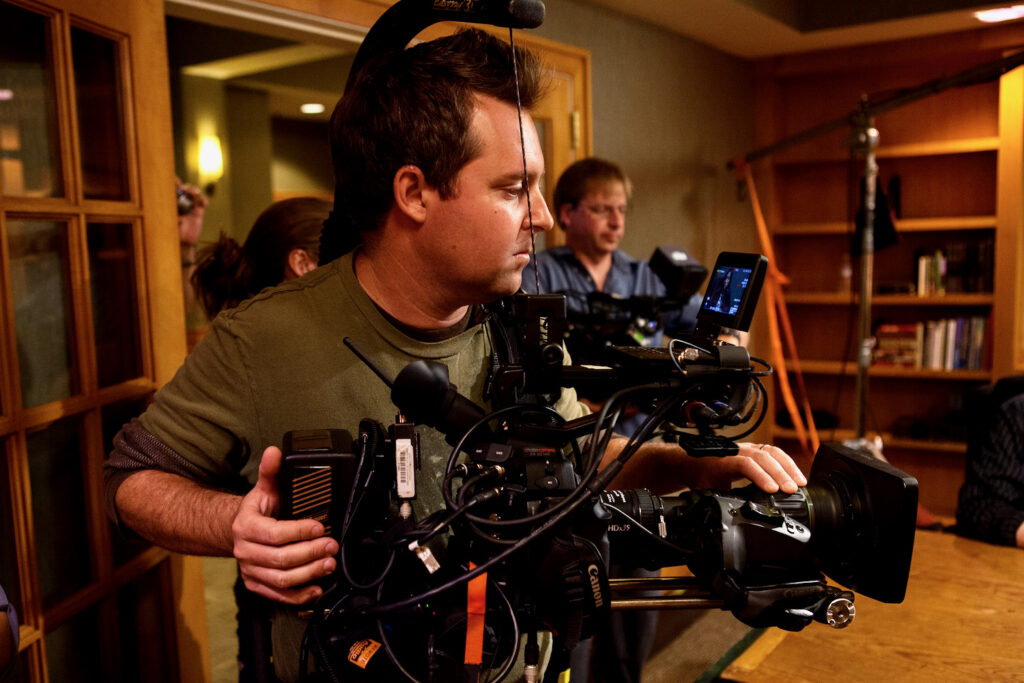Has the “Holy Grail” of cameras finally been created? For years, DP’s such as myself working in the unscripted world have yearned for a camera with a large sensor to shoot our shows to achieve a the cinematic look our friends in the film world can achieve. The Canon 5D Mark II got us pretty close in terms of image. But it certainly failed as an operator-friendly camera with it’s lack of viewfinder, easy way to focus, lack of XLR inputs, a maximum clip length of 12 minutes, and no servo lenses. The C300 is Canon’s answer to these problems to help get us pretty close to unscripted nirvana.
Yes, the C300 looks amazing. It has a sensor size slightly larger than the 7D, comparable to a Super 35mm film frame [Although it is not as large as the Canon 5D sensor (35mm Full Frame), a common misconception]. See chart below. With this large sensor size, you can achieve a very shallow depth of field and create a very “documentary” look by utilizing focus as an element of your visual style, something that is difficult to do with a 2/3″ sensor, the typical size sensor in most ENG-style cameras used for reality TV (such as the Panasonic HDX-900 and Sony PDWF800).

Now it should be noted that he C300 comes in two versions… The C300-PL (for PL-Mount lenses, such as those used by the RED, Alexa, and 35mm film cameras) and C300-EF [for Canon SLR EF-Mount Lenses, like those that fit on the Canon 5D still (SLR) camera.]
(You’ll see why this is important to be aware of soon…)
The issue with shooting reality TV is that using the C300 with the EF mount (using still camera lenses) is that it forces you to use still camera lenses. This causes two problems. First, you have to deal with a limited range of focal lengths in the zoom lenses that are available. Second, there are no servo zooms like we traditionally have on standard 2/3″ ENG reality cameras (such as the Panasonic HDX-900).
So the zooming done by the operator will always be manual, unless you add a Preston zoom control, which is a bit pricey to rent, and a bit large. Now a manual zoom can work, if that’s part of your style… But it may not.
Now for the focal range issue. EF mount SLR lenses simply do not have the focal range that ENG lenses have. You either have to just deal with the limited focal range (the ability to zoom in and out), or you have to stop down the action and change lenses (not great for reality). Or, another option is one camera is always wide, one is always tighter. Depending on your show, this may or may not work. It can probably work for “soft scripted” or “docu-soap” reality, but not for a more documentary-style reality show where you don’t know what is going to happen.
I used this set up for an AT&T “reality” style TV commercial and for part of the pilot episode of “Power Broker” for HGTV. It worked well for the AT&T commercial as we were in a more controlled filming situation. Although we were working with improv actors, we were able to do second takes, and we could take the minute or two to change lenses. For “Power Broker,” I was not so happy with the limitations of the SLR lenses. Besides having a slightly cumbersome rig, we had to move a bit slower than the normal pace of a reality show. Changing the lens also meant adjusting the gear to make the Preston work. But worse than that was when the I needed to zoom in more because the homeowners walked down a long kitchen hallway away from me, I was not able to zoom in enough to get single shots on them. While the producer is on walkie saying “Zoom in! Zoom in!” and I have to reply, “I can’t.” I couldn’t walk in closer due to where my B-camera op was shooting. My only option was to stop the action and change lenses. This is pretty unacceptable for “reality” TV.

(Photo Above: An early configuration of the C300-EF with a Canon SLR lens (EF Mount) with a Preston zoom control in my right hand)
But not all hope is lost.
If you use the C300-PL, you have a few more options for a documentary-style “reality” shooot. Able-Cine makes a $5800 adapter (the HDx35) that allows you to use a 2/3″ ENG style lens and mount it to the C300PL. This restores the full functionality of an ENG camera (you can zoom from tight to wide almost instantly via the servo on the lens). Also, there is no “crop” factor, meaning the lens has the same focal lengths as intended. The two drawbacks are you get a slight vignette at the edges of the image due to the adapter, and you loose 2 1/2 stops of light. I haven’t found either to be much of a problem. The vignette isn’t too noticeable in most situations (unless you are shooting a white wall… Then it’s pretty noticeable), and often looks really nice (especially during interviews!). The camera’s chip is so sensitive (it has a native ISO of 850) that as long as you have a normal lighting package you should be fine. However, if you are shooting a documentary with only available light, you might not want to do this.
(I should also mention that MTF Services makes a similar B4 to PL adapter, but it does have a significant crop factor, around 2.5, and you must use a 2/3″ lens that has a doubler. Bad for most reality shows, but maybe good for shows where long lenses are useful.)
The HDx35 with the Canon 2/3″ ENG HD Lens is the option I have since used for the remainder of HGTV’s “Power Broker” series, “Flip It to Win It” and the newest episodes of “Color Splash: Miami.” I have now shot over 100 days with this setup and have been very pleased with the results.


(Both Photos Above: C300-PL with Able-Cine HDx35 Adaptor and Canon 11×4.7 ENG Lens)
Another option (that is probably the most expensive) is to use the new 19-90mm Fuji Cabrio lens. It is a PL-Mount lens that comes with a servo. It is very expensive to purchase, but may be an affordable rental option. It won’t go quite as wide as the Canon 2/3″ ENG lens I mentioned in the previous section (which IS important for a HGTV show), but it should work fine for a typical reality show and it is tack sharp.
Although I am a C300 fan, another option I would consider looking into is the new Sony F5. It has a lot of similar features and comes with an PL-mount and a FZ-Mount adapter which will allow less expensive lens options (including a Sony lens with a servo for around 12K, the SCL-Z18X140). The camera was released only a few months ago, and may be hard to get your hands on. I have not personally tested it, but it looks solid in its specs, and is upgradeable to 4K, unlike the C300.
Are these compromises worth the extra effort? Depends. If you can shoot in a style to allow for shallow depth-of-field shooting, then it is worth it. You can really capture some cinematic looking stuff that a camera like a HDX-900 simply cannot do since it’s 2/3″ chip is smaller. But your Director of Photography AND Field Producer must understand how to achieve this. If you line up shots that are flat, there is absolutely no advantage. You must change your shooting style to realize the full benefits of the C300 or any large-sensor camera.
I was lucky enough on my first C300 show to have the field producer who trusted me and understand what look I was going for. One people see the results, it’s an easy sell. I think we achieved a look on “Power Broker” (series coming out Summer 2013 on HGTV) that is really unique for unscripted “reality” TV by using the C300. So give it a go if it works for your show!
UPDATE (4/2014):
It seems many people have talked with Canon about this situation (including myself), and Canon has come up with a great solution (although still fairly expensive at $33,000). The new Canon CINE-SERVO 17-120mm T2.95 is a cinema-style lens with a servo rocker (like an ENG lens would have). It comes in either EF or PL-Mount, and can be switched at the factory at a later date if you so decide, likely for a fee. The servo is detachable, so you can use it like a cinema lens with follow focus and matte boxes. The good news is that those focal lengths (17-120mm) should cover your for most reality shows. And it could keep you from having to switch your EF lenses. In fact, you could virtually eliminate the need for your 16-35mm, 24-70mm, 24-105mm lenses, since you get it all in one. The lens doesn’t quite open to a f/2.8 and there is a bit of ramping at the longer focal lenths, but I think most people will be pleased. If you can afford it, this lens answers the question. The C300 is ready for Reality.